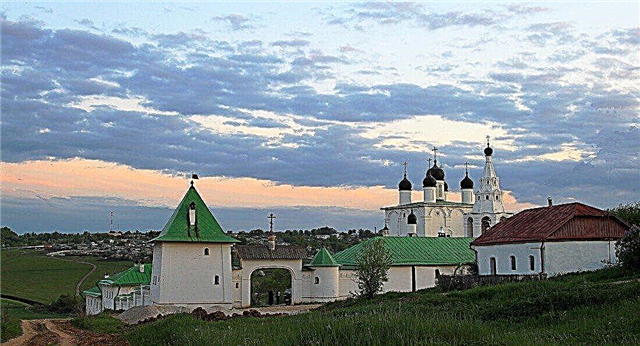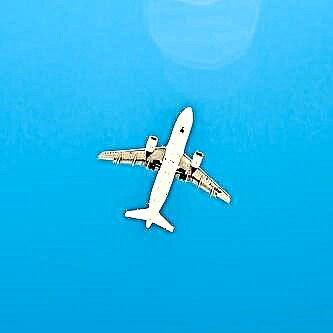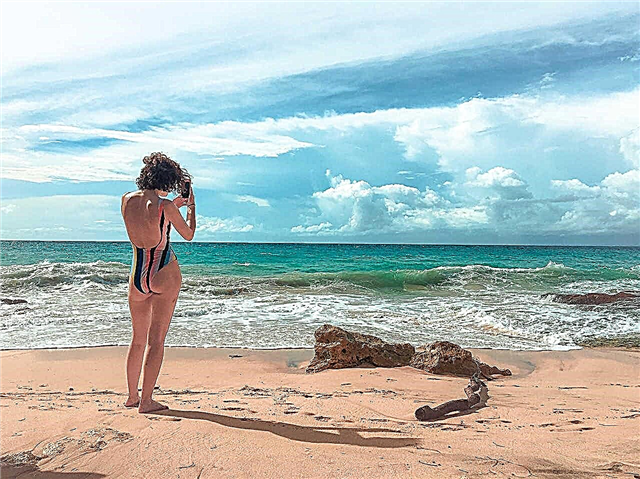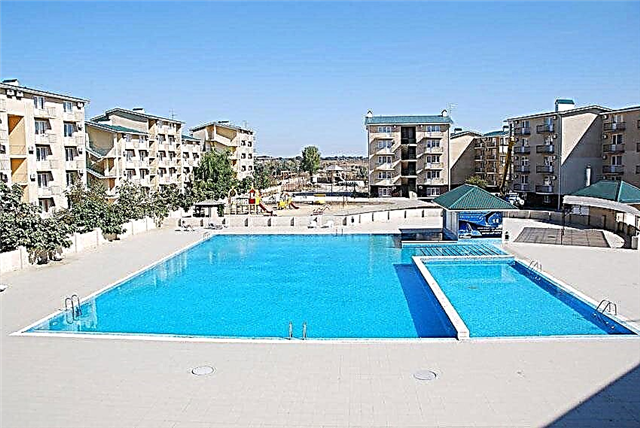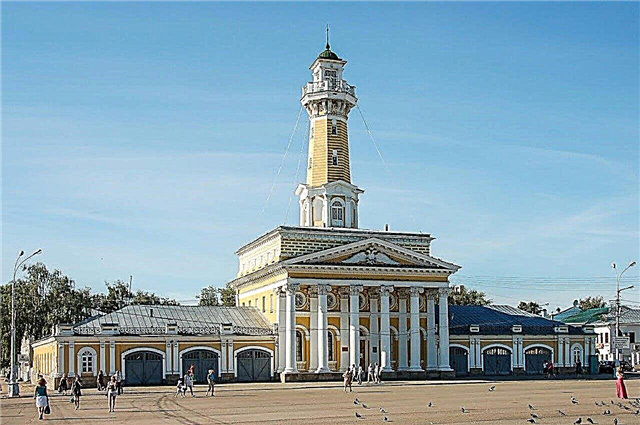The Kostroma region is one of the most attractive distinctive regions of Russia. Many architectural monuments, ancient holy monasteries, magnificent historical ensembles attract thousands of tourists every year. The main pearl of the region is, of course, its capital. Beauty-Kostroma belongs to the "Golden Ring" of Russia. This is a recognized jewelry and linen center of the country, the cradle of the Romanov dynasty, the birthplace of the outstanding Nikolai Ostrovsky and no less legendary Ivan Susanin, the place of residence of the fabulous Snow Maiden.
The Kostroma region is also of interest to fans of ecological tourism. There is a unique elk farm, picturesque corners of nature - nature reserves "Kologrivskaya floodplain" and "Kologrivsky forest". Local lakes - Galich and Chukhlomskoe - are also on the list of natural attractions of the region.
The most interesting and beautiful places in the region
List, photos with names and descriptions of the best attractions!
Fire tower in Kostroma
A magnificent architectural monument in the center of Kostroma - on the main square of Susaninskaya. It was built in 1825. Made in antique style. Includes guards and living quarters, stables, sheds, a 35-meter observation tower. A museum is open here today. In addition to the watchtower, Susaninskaya Square, popularly nicknamed the "frying pan", is decorated with other historical buildings - the Borshchov House, the famous Trade Rows, the Building of Public Places.

Holy Trinity Ipatiev Monastery
The main religious attraction of the Kostroma region, founded in 1330. It was within these walls, in 1613, that the first of the Romanov dynasty, Mikhail, was called to the kingdom. The monastic complex includes more than 10 buildings, among them - the Trinity Cathedral with a bell tower, the Catherine's Gate, the Romanov Chambers, the Archimandrite Corps, the Godunovs' tomb, etc. A church history museum is open on the territory of the monastery.

Museum-reserve "Kostromskaya Sloboda"
A complex of original wooden structures of the 16th-19th centuries. - true masterpieces of Russian architecture. It is located within the city, near the walls of the Ipatiev Monastery. These are real, not reconstructed buildings brought from different parts of the region. The first exhibit appeared in 1955. Today, on the territory of the museum - 2 chapels, 3 temples, 8 residential buildings, baths, barns, a mill. The interior decoration of churches has been preserved, in houses there are antique furniture and household items.

Sumarokovskaya moose farm
The only moose farm in Russia. Located in the Krasnoselsky district, it was created in 1963. Open to visitors all year round. Moose are tame here, they can be stroked and fed. The favorite delicacy of animals is carrots and black bread. And also there is a unique opportunity to taste moose milk, which has healing properties. The nearby sanatorium im. Susanina uses milk in her wellness programs.

Museum-reserve "Shchelykovo"
The family estate of the Ostrovsky family. Alexander's father acquired it in the middle of the 19th century. The playwright wrote most of his works here. In the status of a museum - since 1936. There is a whole complex of interesting objects on its territory. This is the house of the writer, the house-museum of Ivan Sobolev, a woodcarver and friend of Ostrovsky, the residence of the Snow Maiden, a literary and theater museum, a functioning temple, a church cemetery, a monument to the writer, a landscape park with a two-story gazebo.

Epiphany-Anastasiin Monastery
Founded in Kostroma in the 15th century by one of the students of Sergius of Radonezh. Was originally masculine. In the 19th century, it was occupied by nuns from the Anastasia monastery, and the monastery acquired a double name. The monastery is closed for tourists, you can only enter the territory of the Epiphany Cathedral, the oldest surviving building. It contains the valuable Fedorovskaya miraculous icon of the Mother of God, dating back to the 12th century, one of the shrines of the imperial house of the Romanovs.

Reserve "Kologrivsky forest"
Located in the north of the region. Organized in 2006. The area is 59 thousand hectares. The purpose of creation is to protect large tracts of pristine coniferous forests of the southern taiga. The inhabitants of the reserve are moose, lynx, bears, wild boars, as well as the Red Book golden eagle, snake eagle, peregrine falcon, osprey. Educational excursion routes have been developed for tourists. Nearby there is the former monastery of Knyazhaya Pustyn, the Assumption Cathedral, local history and ethnographic museums.

Reserve "Kologrivskaya floodplain"
Every spring in the floodplain of the Unzha River, in Kologriva, flocks of wild geese, flying to the polar tundra for breeding, stop to rest. According to statistics, during one migration season, 30-50 thousand individuals are in this place, replacing each other. There are also other species of birds. Such a congestion of birds, and even near a settlement, is a rare occurrence for the whole of Russia. Therefore, the territory received the status of a state reserve.

Monument to Ivan Susanin
The first monument to a Russian peasant, who became famous for his fortitude and devotion to the tsar, was erected in the center of Kostroma in 1851. It consisted of two figures - Tsar Mikhail and Ivan Susanin. After the revolution, the monument was destroyed. A new monument in the central square, between the stalls, was erected in 1967. This is the figure of a large and strong man in long robes, with a staff in his hands, standing on a massive pedestal.

Ostrovsky's gazebo
Built in 1956 near the river station, on the high bank of the Volga. It has 7 snow-white columns and a hemispherical dome, reminiscent of park gazebos in old Russian estates. Named after Alexander Ostrovsky, since the life and work of the playwright are closely connected with Kostroma. Viewers could see this gazebo in the film "Cruel Romance", based on "The Dowry", one of the most famous plays of the writer.

Shopping arcade
A large shopping complex of the 18th-19th centuries, stretching for several blocks from the central square to the banks of the Volga. The first to be built were the Red and Flour rows, which surrounded Susaninskaya Square. At the same time, the temple, built here earlier, very harmoniously fit into the complex of the Red Rows. Later, Fish, Bread, Tobacco, Kvass and other rows were added. Most of the buildings have been perfectly preserved to this day and continue to function as before.

Museum-estate "Flax and birch bark"
Private museum in Kostroma, dedicated to two ancient folk crafts. Opened in 2005. In the flax hall there are weaving looms and spinning wheels, folk costumes, linen dolls. Characters from Russian fairy tales and other wickerwork are demonstrated in the birch bark hall, the birch bark samovar with a tea set is especially impressive. Master classes are held for those who wish. There is also a souvenir shop where you can buy amulets, toys, boxes and much more.

The Snow Maiden's property in Kostroma
On the banks of the Volga there is a fabulous town with a wooden tower. Its hostess Snegurochka invites guests to watch a puppet show, talk to Santa Claus using a magic mirror, visit the Christmas tree museum and visit the real Ice Room. And also in the Snegurochka possessions there is a museum "Fairy land" in the center of Kostroma. Among its exhibits is a collection of ancient household items, dolls in folk costumes, amulets and amulets.

Znamensky Convent
Founded in 1993 at the Resurrection Church. He also received the Znamenskaya Church under his jurisdiction. These two churches were built in the 17th century and constituted a single architectural ensemble.In the 30s, the Znamensky Church was abolished, the bell tower was destroyed, the building was given to a stoker. After the creation of the monastery, work began on the revival of the shrine - the bell tower was rebuilt, the interior of the temple was restored. A medical center and an almshouse were opened at the monastery.

Galich lake
The largest body of water in the region. The origin is glacial-tectonic. Area - more than 70 km2, the average depth is only 1.3 m. Thickets of aquatic vegetation cover more than half of the lake's surface. It has long been famous for its notable fishing. At the bottom there are layers of sapropel used in medicine and agriculture. Local legend says about 12 sunken ships with gold, waiting in the wings. The city of Galich is located nearby.

Church of the Epiphany (Krasnoe-on-Volga)
The only tent-roofed stone temple in the region. It appeared in the 16th century, when the village of Krasnoye belonged to the Godunovs. A century later, the bell tower was completed. In the 19th century, the temple complex was replenished with the Church of Peter and Paul, a monument to Alexander II, and also there was a parish cemetery on its territory. Unfortunately, none of this has survived. The temple was in operation until 1932, then it was used for household needs. In the 90s it was returned to the Church.

Avraamiev Gorodetsky Monastery
It is located near Lake Chukhloma, in the small village of Nozhkino. It was founded in the XIV century by the monk Abraham, a disciple of Sergius of Radonezh. His relics are kept in the monastery. Over the course of several centuries, the architectural ensemble of the monastery was formed - 3 churches, a bell tower, a chapel, a necropolis, a cell building, etc. In the 20s of the last century, the monastery was abolished and partially destroyed. His return to the Church took place in the early 90s.

Manor Sledovo
The noble family estate of the Kartsev family with a luxurious regular park in the village of Sledovo. In the mid-80s, a children's camp of one of the schools of Kostroma was located on its territory. Through the efforts of the director Y. Karvatsky and the students, the territory of the estate was ennobled, the main house was repaired, the pond was cleaned, and an orchard was laid. An ecological and biological center for schoolchildren has been opened here today. An enchanting Flower Ball is held annually.

Museum "Collection of the Nobility"
A respectable merchant mansion of the 18th century once housed the noble assembly of the province. Today within its walls there are exhibitions dedicated to the life of the Kostroma aristocracy two centuries ago, as well as the life of townspeople of different classes. Costumes, household items and carefully recreated interiors of the halls bring history to life in front of visitors. The special pride of the museum is the luxurious marble White Hall, where concerts are often held.

Romanov Museum
It is located in the center of the city, in a white-stone old building. In 2013 it celebrated its 100th anniversary. Conceived as a dynastic museum of the royal house of the Romanovs. The first excursionists were members of the imperial family; their autographs have been preserved in a memorial book. Today, in addition to expositions of the Romanov theme, there is an exhibition dedicated to the boyars and the events of the Time of Troubles, a collection of works of art from noble estates is presented here.

Museum of jewelry art in Kostroma
Created in 2013 by the trade group "Amethyst" with the support of Kostroma artists, art critics, collectors. The museum covers the period from the 18th century to the present day. Here you will find jewelry made both by artisan craftsmen and in modern production, jeweler's tools, reconstruction of a workshop and a jewelry store. Of particular interest are items made of the finest precious threads, made using the "Krasnoselskaya scan" technique.

Monument to V.I.Lenin in Kostroma
The uniqueness of this monument is that the figure of the leader stands on someone else's pedestal. It was intended for representatives of the Romanov dynasty, and the top was supposed to be decorated with a two-headed eagle. The monument was erected with donations from the people, and by 1916 the foundation of the monument and 28 bronze figures were already ready. But the further installation of the composition was interrupted by the revolution. The bronze statues were sent to be melted down. And in 1928, a reinforced concrete statue of Lenin appeared.

Terem in Pogorelovo
A richly decorated two-story wooden house is the only surviving building in the abandoned village of Pogorelovo. It was built at the beginning of the last century by a wealthy peasant Ivan Polyashov. After the revolution, the tower was requisitioned, it began to collapse, like other huts in the village. But he accidentally caught the eye of the artist from Moscow Anatoly Zhigalov. The Muscovite bought the house from the state and stayed in it, thus preserving this unique structure.

Makaryevo-Unzhensky monastery
A male monastery in Makaryev. It was founded by the Monk Elder Macarius in the XIV century. His relics are kept in one of the cathedrals of the monastery. Representatives of the royal family often visited here. By the 18th century, the main architectural ensemble was formed - 5 churches, buildings for brethren, hospital cells, and a refectory. After the revolution, the monastery buildings were used for household needs. The renovation work began in the 90s and continues to this day.

Paisievo-Galichsky Assumption Monastery
A functioning monastery in the city of Galich. Founded in the XIV century, it was originally male. It is named after the Monk Paisios, the abbot who lived here in the 15th century and was famous for his virtuous deeds. His relics are kept on the territory of the monastery. The two main buildings - the Trinity Church and the Assumption Cathedral - were erected in the middle of the 17th century. After the devastation and inaction during the Soviet period, the monastery began its revival in 1994, but as a female one.

Jacob-Zheleznoborovsky Monastery
An active male monastery in the village of Borok. Date of foundation - XIV century. The Monk Jacob Zheleznoborovsky, who founded the monastery, was one of the disciples of Sergius of Radonezh. Here Grigory Otrepiev, the future False Dmitry I, was mowed into monasticism. Stone buildings that have survived to this day began to appear in the 18th century. Under Soviet rule, the monastery was inactive. The revival of monastic life and restoration work began in 1994.

Cathedral of the Transfiguration in Sudislavl
One of the oldest architectural monuments in the city. It was built of stone in 1758 on the site of the former wooden church. An important event in the history of the cathedral was the visit of Tsarevich Alexander, the future Russian emperor, in 1837. Since the late 1920s, the temple was inactive, services resumed after 1945. The architectural ensemble of the cathedral consists of a temple, a 43-meter bell tower, outbuildings, a gatehouse, and a stone fence.

Resurrection Church in Susanino
The white stone five-domed temple with a bell tower is well known to everyone thanks to the artist A. Savrasov, who captured it in his painting "The Rooks Have Arrived". It was built in 1690 at the initiative of a representative of the famous noble family, Pyotr Saltykov. Rebuilt several times. In the 30s of the last century, the temple was closed, while the chapters were broken, the bells were removed, all the icons were burned. At the end of the 20th century, after restoration, the Susanin Museum was located in the building of the church.

Chukhloma lake
The second largest lake in the region. Square - 49 km2, average depth - no more than 1.6 m. It is of glacial origin. It is rich in fish resources, the most valuable species is the large Chukhloma goldfish. Thickness of silt sapropel deposits reaches 5-7 m. During excavations on the coast, large sites of ancient people were discovered. Also interesting for tourists is the 17th century monastery located nearby. The town of Chukhloma is located nearby.

Susaninskoe swamp
Natural monument. The area is 1.8 thousand hectares. It also has other names - Isupovskoe, Clean. Located 1 km from the village of Isupovo. A habitat for elk, and during migration - a place of gathering of wild geese.An important historical site associated with the feat of the legendary Ivan Susanin. A huge boulder at the edge of a swamp with the name of a national hero reminds of him. Through the reservoir, special paths have been laid, along which excursions, including theatrical ones, are conducted.



